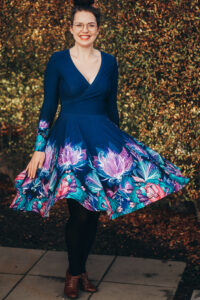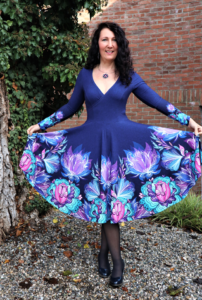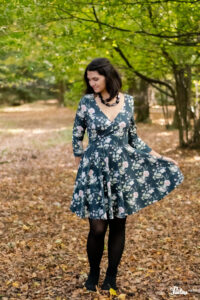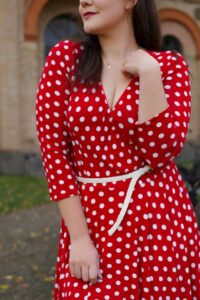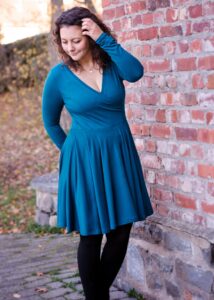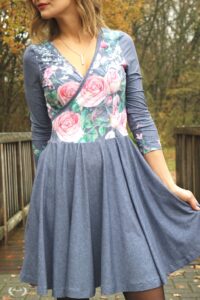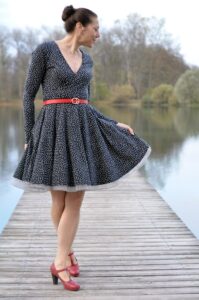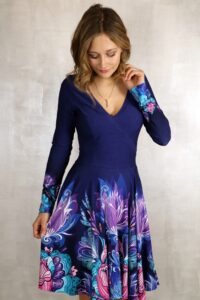zum Warenkorb 0,00 €
0Nähanleitung /// How to sew: Nova
Tellerrock-Kleid mit Wickeloptik und Wiener Nähten
Dress with circle skirt and wrap look
The pattern is designed for a person who is 170 cm tall and has a B cup.
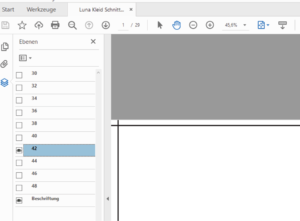
Richtige Größe drucken
Print the correct size
Maßtabelle /// Size chart (cm)

Stoffbedarf alle Größen/// Fabric requirements all sizes: 2,6 m
Anpassung
Das Kleid liegt an Brust und Taille figurnah an und fällt nach unten hin sehr locker. Wähle deine Größe anhand des Brust- und Taillenmaßes aus.
Sollte die Differenz zwischen deinem Oberbrust- und deinem Brustumfang größer als 5 cm sein, entscheide dich für eine FBA zur Anpassung. Mehr zum Thema FBA findest du in unserem Blog
Solltest du Hilfe benötigen, schau gern in der Mondstoff-Gruppe auf Facebook vorbei: Mondstoff-Gruppe
Adjustment
If you need help, feel free to join the Mondstoff group on Facebook: Mondstoff Group
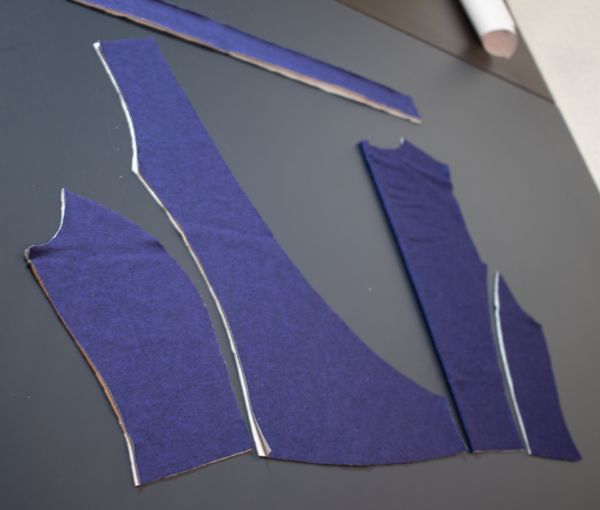

1. Zuschnitt
2x vorderes Mittelteil in doppelter Stofflage
2x vorderes Seitenteil in doppelter Stofflage
1x hinteres Mittelteil im Bruch
2x hinteres Seitenteil in doppelter Stofflage
2x Rock im Bruch
2x Ärmel in doppelter Stofflage
Ausschnittstreifen nach Tabelle (je nach Dehnbarkeit des Stoffes ist es ggf nötig, den Streifen etwas länger zuzuschneiden)
Übertrage beim Zuschnitt alle Passzeichen mit einem kleinen Knips innerhalb der Nahtzugabe.
Der Stoffbedarf ist mit 2,6m sehr großzügig angegeben und entspricht dem maximalen Verbrauch für eine Nova mit langen Armen bei einem gemusterten Stoff. Für kurze Ärmel und uni Stoffe ist der Bedarf deutlich niedriger. Faustregel: der Stoffbedarf beträgt 2x die gewünschte Rocklänge plus gewünschte Ärmellänge.
1. Cutting
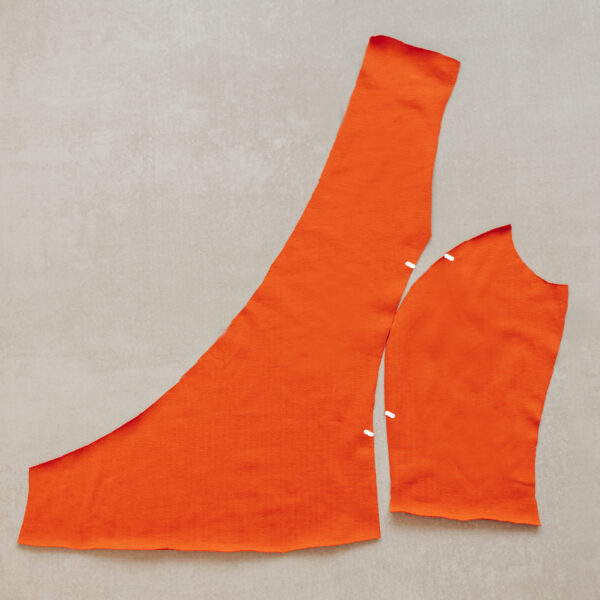
2. Vorderteil nähen
Das Vorderteil hat sogenannte Wiener Nähte, die das Oberteil in Form bringen.
Nähe zunächst die vorderen Seitenteile jeweils an das dazugehörige Mittelteil. Orientiere dich beim zusammenstecken an den Knipsen. Nutze dazu die Overlock oder einen elastischen Stich deiner Nähmaschine.
Die Nahtzugaben Richtung vordere Mitte bügeln.
2. Sewing the front
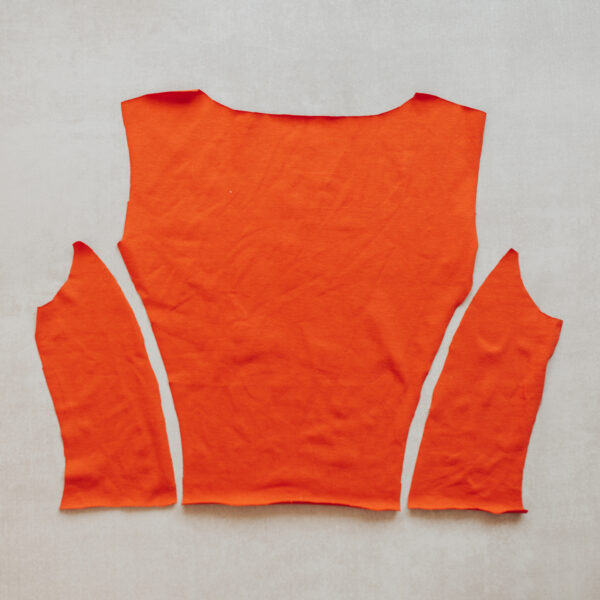
3. Rückenteil nähen
Nähe die Seitenteile jeweils an das mittlere Hinterteil. Die Nahtzugaben Richtung hintere Mitte bügeln.
3. Sewing the back
Sew the side pieces to the middle back piece. Iron the seam allowances toward the center back.
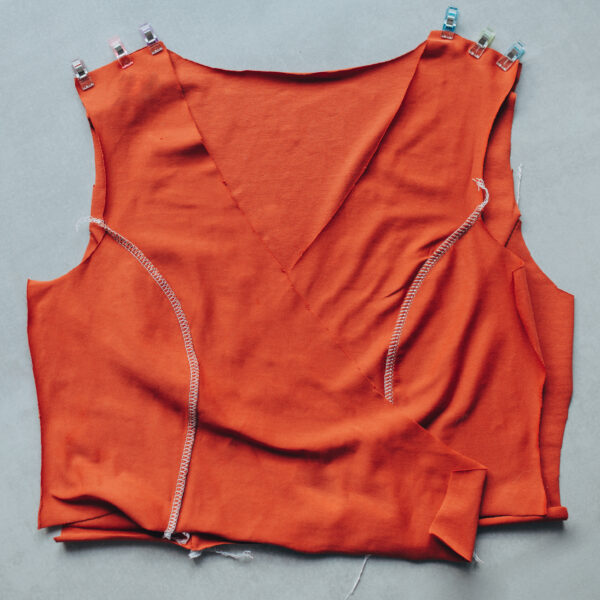
4. Schulternähte schließen
4. Closing the shoulder seams
Now close the shoulder seams by sewing the front pieces to the back piece, right sides together. Iron the shoulder seams toward the back.
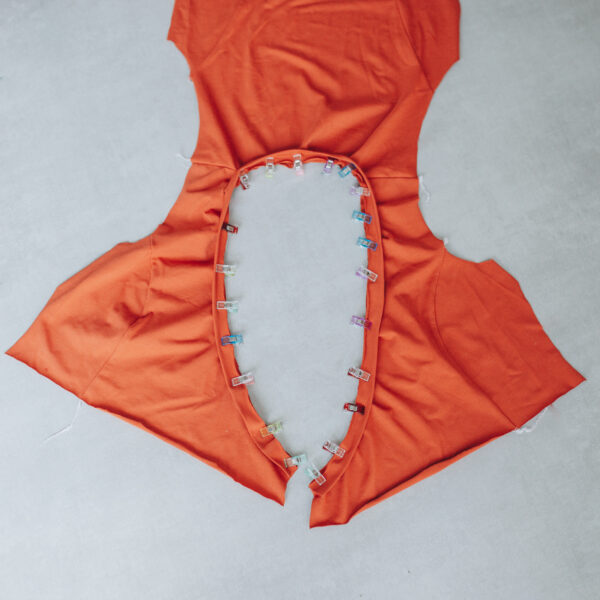
5. Ausschnittstreifen annähen
Bügle den Ausschnittstreifen links auf links zur Hälfte. Stecke ihn nun rechts auf rechts mit den offenen Kanten auf die Kante des aufgeklappten Oberteils. Der Streifen muss dabei gedehnt werden. Nutze zum festnähen einen elastischen Stich. Wenn du mit der Overlock nähst, kannst du das Differential etwas erhöhen. Dies verhindert ein Ausleiern der Ausschnittkante. Bügle die Nahtzugabe in Richtung Oberteil und steppe den gesamten Ausschnitt knappkantig von rechts ab.
5. Sewing the neckline
Iron the neckline strip in half, wrong sides together. Now pin it right sides together with the open edges on the edge of the unfolded upper part. The strip needs to be stretched. Use an elastic stitch to sew. If you sew with the serger you can increase the differential a bit. This prevents sagging. Iron the seam allowance in the direction of the bodice and topstitch the entire neckline from the right edge.
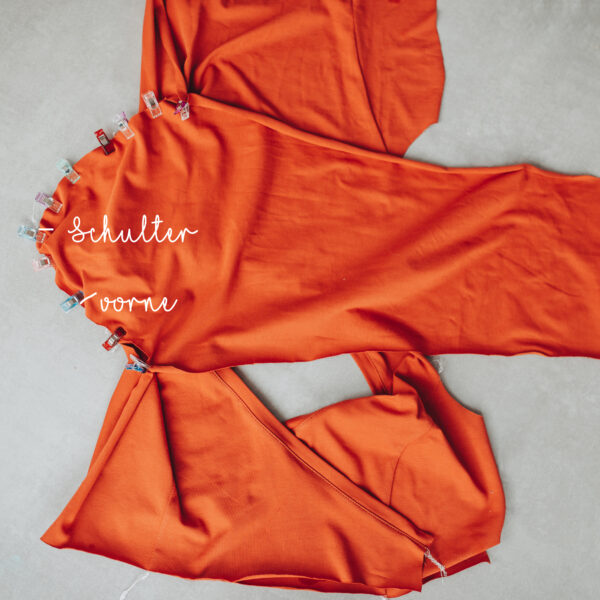
6. Ärmel annähen
Stecke nun die Ärmel rechts auf rechts an das Oberteil. Beachte hier die Knipse für die Schulter und das Vorderteil und nähe sie mit einem elastischen Stich fest. Der Knips des Ärmels trifft vorne auf die Wiener Naht.
6. Sewing the sleeves
Pin the sleeves to the bodice, right sides together. Note the snaps for the shoulder and front piece here and sew them in place with an elastic stitch. The snap of the sleeve meets the princess seam at the front.
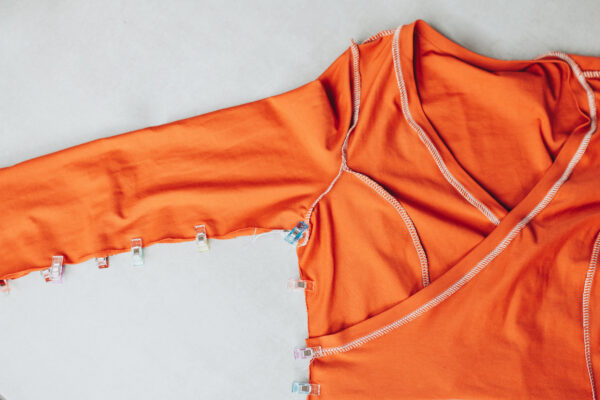
7. Seitennähte schließen
Stecke nun Ärmel und Oberteil rechts auf rechts und schließe die Seitennähte in einem Rutsch. Das Vorderteil wird dabei in der jeweiligen Seitennaht fixiert. Optional kannst du die untere Kante des Oberteils mit großer Stichlänge zusammenheften, damit beim Annähen des Rockes nichts verrutscht.
Markiere dir die vordere und hintere Mitte. Säume die Ärmel. Klappe dafür die Saumzugabe von 2 cm nach innen und nähe sie mit einem elastischen Stich oder einer Zwillingsnadel.
7. Closing the sideseams
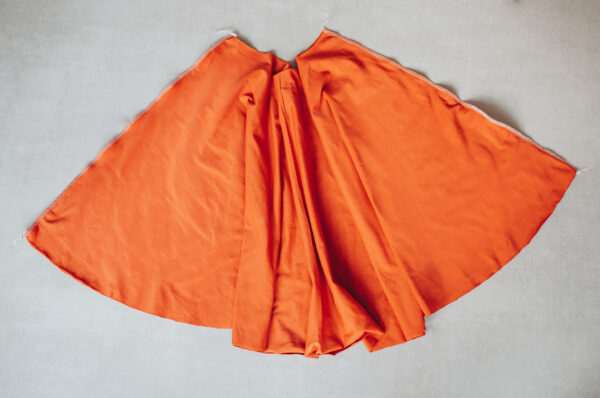
8. Rock nähen
Markiere dir an deinen Rockteilen jeweils die vordere und hintere Mitte. Stecke beide Rockteile rechts auf rechts und nähe sie zusammen.
Stecke nun den Rock rechts auf rechts an das vorbereitete Oberteil, sodass die hinteren und vorderen Mitten sowie die Seitennähte aufeinander treffen.
8. Sewing the skirt
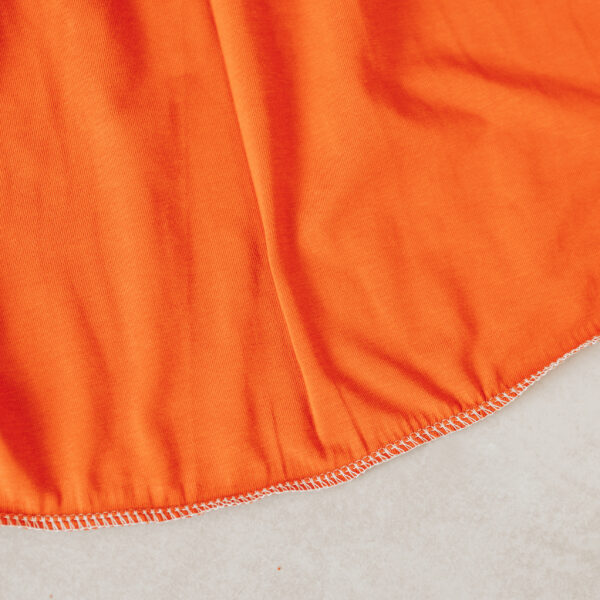

9. Tellerrock säumen
Tellerröcke solltest du grundsätzlich so schmal wie möglich säumen. Der Rock nimmt von oben nach unten an Weite zu, je mehr du umklappst, desto größer ist der Unterschied zwischen den Weiten, was zu Mehrweite im Saum und dementsprechend Falten führt.
Variante 1:
Stelle an deiner Overlock den Differentialtransport etwas nach oben, sodass sich der Stoff beim Versäubern leicht kräuselt. Die Mehrweite wird so automatisch eingehalten. Klappe den Saum 0,7 cm nach innen und steppe ihn ab. Das ist die schnellste Methode. Durch das leichte Kräuseln legt sich der Saum fast automatisch in Form.
Variante 2:
Bügeln und Geduld. Klappe immer eine kleine Strecke deines Saumes 0,7 cm um und bügle mit viel Dampf. Fixiere die Strecken mit Klammern oder Nadeln und arbeite dich so einmal um den ganzen Rock. Die Mehrweite hälst du dabei von Hand etwas ein. Das Bügeleisen ist hier unverzichtbar.



